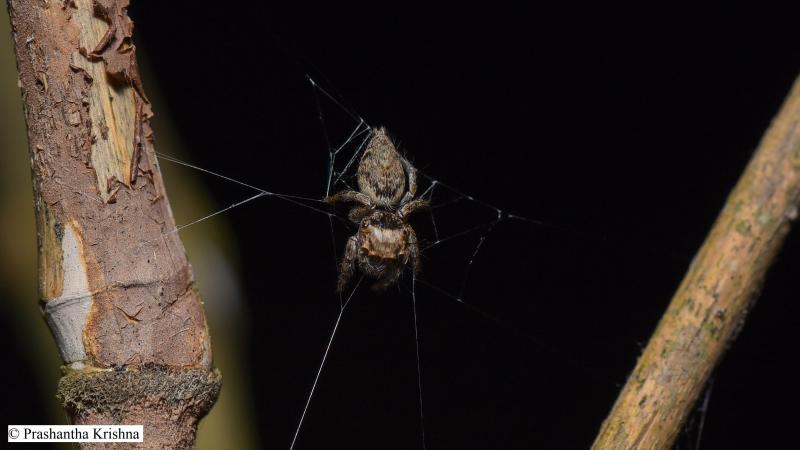
A jumping spider is a master hunter, with large eyes and ability to leap vast distances. They belong to the family Salticidae and are one of the most abundant species on the planet. Their cute front eyes, colours, and elaborate patterns can make even an arachnophobe reevaluate their fears. However, these traits, along with their ability to jump vast distances to capture their prey, makes them textbook examples of active hunters. An active hunting lifestyle is no easy task, and even a spider needs a little rest! But, unlike most spiders, these don’t build webs to catch their prey. They do however build nocturnal shelters—a silken home used to retreat to at night.
The nocturnal retreats of salticids are as diverse as the spiders themselves. Jumpers from the Asemonea sp. build a thin sheet out of silk under leaves, while others like Hyllus sp. and Telamonia sp. build a silk platform between leaves. The weaver, ant-mimicking spider Myrmarachne sp. builds elaborate tubular shelters with multiple entrances. In a recent discovery, researchers from India and the USA have found that Anarrhotus sp.— a jumper from the family Salticidae—weaves an orb-web as its nocturnal home. But building orb webs is a characteristic of another family of spiders—the Araneidae.
The study, published in the journal Peckhamia, found that adults and juvenile Anarrhotus sp. jumping spiders, spotted in southwest India, used their orb-webs only as a nocturnal retreat, but not to catch prey.
“This jumping spider exhibits similar behaviour to that of an orb-weaver,” says Dr Abhijith from Mysuru, who is the lead researcher of the study. “Each orb-web is usually oriented vertically on a plant. Like the spokes of a wheel, it is made up of a series of silken threads that meet at the centre of the web or the hub. The construction of the hub and associated radii resembles the early stages of an orb-web that an araneid spider would make”, he explains, detailing the looks of the web.

Anarrhotus sp. on orb-web
There are few ways in which a spider can efficiently build a web of this kind. The similarities between the orb web made by the salticid jumper and that of an araneid spider could reflect how these two families use the same approach to solve a common problem—escaping from hungry nocturnal predators. While suspended on its web, the Anarrhotus sp. may be alerted of a potentially dangerous predator, similar to an orb-weaver. The vibrations from this would-be predator get transmitted to the hub of the web along the silken threads, thus helping the jumper to escape.
The orb-web of the salticid is also used as a ‘moulting sac’—a safe place for the spider to shed its old exoskeleton. A second edition of the study, published by the same group of researchers, details how an Anarrhotus sp. jumper moults, while hanging from a silken thread in the web called a dragline. This moulting behaviour is similar to that of many wandering and web spiders from different families. Taking advantage of gravity, the Anarrhotus sp. lowers itself along the dragline and sheds its old exoskeleton.
Although moulting is linked with mating in some orb-weaving spiders, not much is yet known about this jumper’s courtship and mating behaviour. Also, since most jumping spiders build a protective sac for their young ones, this raises the question of how Anarrhotus sp. might protect its brood, if it builds an orb-web and not a sac-like retreat. The researchers speculate that this jumper might still make a protective sac for its spiderlings, like most wandering and web building spiders do.
“It was by chance that I spotted this jumping spider in the middle of its web while on a nightly spider hunt. Although still in disbelief, I shared my observations on social media. To my surprise, I was met with more images and videos of this strange behaviour. This salticid has been tentatively identified as a relative of the Malaysian species Anarrhotus fossulatus,” details Dr Abhijith. His discoveries might be tantamount for any future research on salticid behaviour.
Editor's Note: This article has been edited to correct an error. The error is regretted.
This article has been run past the researchers, whose work is covered, to ensure accuracy.
